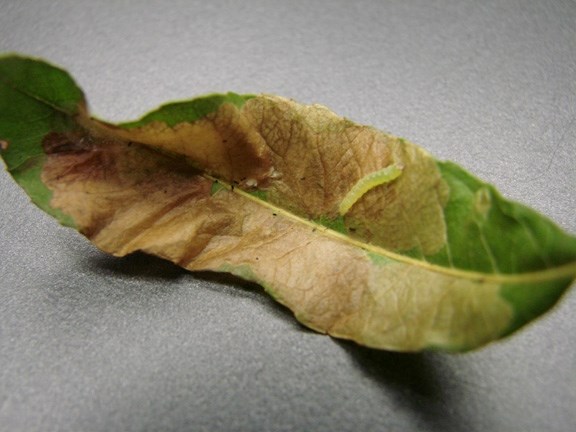This summer a lot of people are more than a little concerned about the health of willows in northeastern Alberta. Many have observed that the foliage on a lot of willows, over a huge area, has turned brown. In fact, if you live in northeast Alberta and haven't noticed this, you probably haven't been outside for a while. Many people have been asking, “What's killing all the willows?” The response to this, in most cases, is, “Don't worry; most of the willows will be all right.”
This year appears to be a banner one for what is typically considered a minor insect pest – the Willow Leaf Miner (Micrurapteryx salicifoliella). This insect is a small moth species (the adult moth has a wingspan of approximately 8mm) that is native to Alberta. The damage to willow foliage, that is so noticeable this year, is caused by the larvae of this moth feeding (mining) inside the leaves.
The browning foliage resulting from damage caused by this insect does give the appearance that severely infested willows are dead. However, this is not the case in most instances. Like most broadleaf species, willows can survive periodic events causing quite a lot of damage to their leaves. Usually, it takes several consecutive years of severe infestation by Willow Leaf Miners before willows a noticeably impacted. Of course, the growth rate and general health of infested willows will decline in years with high populations of the moth. If leaf damage is coupled with other factors such as drought conditions or other insect pests, some dieback of branches or even willow mortality can occur. But death is rarely the result of infestation by Willow Leaf Miner alone.
Willow Leaf miner activity has been noticeable in many areas in northeast Alberta for several years now, but in 2010 its population appears to have increased dramatically. Browning willows are clearly evident over a vast expanse. Reports suggest that severe infestations are occurring throughout all of northern Alberta, not just the northeast. It boggles the mind to imagine just how many of these small insects it must have taken to cause such extensive impacts over such a large area. Spectacular as this event is, keep in mind that this pest's damage does not usually cause permanent injury to the willows it infests. If population levels remain as high as they are this summer for several consecutive years, then concerns may become more justified. For now, however, despite the current unsightly appearance of many willows in northern Alberta – don't worry, most of them will be all right.



